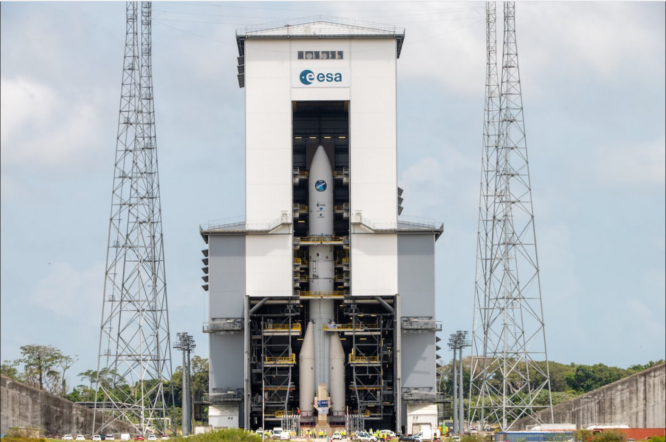On the eve of launching its first ViaSat 3 internet satellite on a SpaceX rocket, Viasat announced that it has moved the launch of an identical spacecraft away from Europe’s long-delayed Ariane 6 rocket and is evaluating proposals from other rocket companies.
The decision means the launch contract for the third ViaSat 3 internet satellite, the final satellite in a constellation of three satellites Viasat is deploying to provide global broadband connectivity from orbit, is up for grabs.
In 2018, Viasat announced the selection of SpaceX, United Launch Alliance, and Arianespace to launch one ViaSat 3 satellite each, thereby awarding launch contracts to three industry leaders.
Following a succession of delays throughout April due to technical and weather concerns, SpaceX is scheduled to launch the first ViaSat 3 satellite on a Falcon Heavy rocket from Kennedy Space Center on Sunday night. The launch of the second ViaSat 3 satellite on ULA’s Atlas 5 rocket remains scheduled for late 2023 or early 2024.
Internet service will be provided by the first two ViaSat 3 satellites across the Americas, Europe, the Middle East, and Africa.
The third ViaSat 3 satellite, named ViaSat 3 APAC and designed to serve the Asia-Pacific region, will no longer launch on Arianespace’s Ariane 6 rocket, according to Dave Ryan, president of Viasat’s space and commercial networks.

Following years of delays, the first test flight of the Ariane 6 rocket, which the European Space Agency and ArianeGroup are developing to replace the mainstay Ariane 5, is now slated for no earlier than the end of this year. According to Ryan, once the Ariane 6 is operative, European government and ESA payloads will be the first to fly on operational Ariane 6 missions.
As a result of Russia’s invasion of Ukraine, a number of these satellites were removed from Russian Soyuz launchers.
“Unfortunately, we had to switch to the Ariane because they were having trouble getting the Ariane 6 ready, and then when the war broke out, some of the launches that they were responsible for on Russian launchers had to be transferred to their Ariane vehicles,” Ryan told CBS News.
“That moved us to the back of the line,” Ryan said. Due to the late hour, we were forced to solicit bids for the third satellite, and we are currently evaluating the proposals.

Viasat, headquartered in Carlsbad, California, is deploying the three-satellite ViaSat 3 constellation into geosynchronous orbit to expand the availability of its consumer internet service to global markets. Each ViaSat 3 satellite constructed by Boeing has a launch mass of over 6 metric tons (over 13,000 pounds) and carries a ViaSat-developed Ka-band communications payload.
Due to the heavy weight of the ViaSat 3 satellites and Viasat’s preference for launchers that position the satellites close to their final operating altitude, the company will likely only consider the most powerful commercially available rockets for the ViaSat 3 APAC mission.
The final Ariane 5 rocket launch is scheduled for June, and all remaining Atlas 5 rockets are reserved until the company retires the vehicle in favor of the Vulcan Centaur rocket. The debut launch of Japan’s new H3 rocket, which was technically capable of launching a satellite as hefty as a ViaSat 3 spacecraft, failed in February.
Blue Origin’s New Glenn rocket is not anticipated to be ready for a commercial mission by mid-2024, when Viasat’s third ViaSat 3 satellite is scheduled to be launched.
This leaves SpaceX’s Falcon Heavy and ULA’s Vulcan as the most probable candidates for the launch contract for the Asia-Pacific satellite ViaSat 3.

